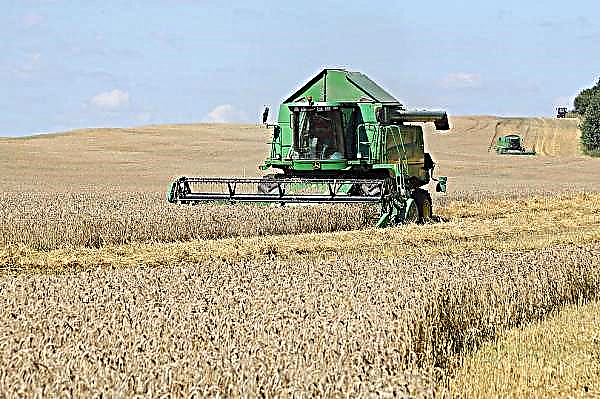Bees are transported when buying, moving or for roaming to places of active honey collection. It is very important to properly organize the whole process and bring the hives and bee colonies whole to the right place. About the nuances of such transportation - further in the article.
Features of the transportation of bees
Transportation of beehives is done at certain times and is stressful for bees.
How long can bees be transported?
Bee colonies can be transported no earlier than a cleaning departure in spring. After it comes the best time to transport hives. The number of individuals in the bee colony at this time is minimal, the cells are not full.
Did you know? On our planet, there are about 21 thousand species of bees. They live on all continents except Antarctica, not all of them store honey.
The free space promotes better ventilation and avoids overheating, so the microclimate in the house during transportation does not change too much. In the summer, the hives already have a lot of brood and immature honey, the frames are not completely filled. In the heat, insects can become stewed and die in the absence of proper ventilation.

The best time is considered to be evening and night or early morning, when there is no heat and the bees respond less to stress. In the evening, all insects are already completing flights and are in the house. In spring and autumn, when there is cloudy or rainy weather, moving is done in the daytime. This can be done, since in such weather the insects are unlikely to leave the nest and the entire bee family is at home.
Transportation of bees for honey collection is completed when the time of wintering is approaching and before the formation of the club. Usually these insects gather in the club in October - November. After that, it is not recommended to transport them. Accordingly, in winter transportation is carried out only as a last resort.
How do bees react to moving?
When transporting honey insects are anxious due to changes in their familiar environment. Any extraneous sounds (rumble of a car), shaking while driving, an enclosed space - all this makes them nervous. In this case, metabolic processes are accelerated, and the need for oxygen increases many times. They will try to find a gap and fly out.
An excited state leads to an increase in temperature in the hive, a higher consumption of honey and an increase in humidity. At high temperatures, the honeycomb can break off and crush the inhabitants of the hive, among which may be the uterus. In hot weather without proper ventilation, bees can die due to steaming.
Preparing for transportation
It is imperative to prepare the hive for moving and stock up on everything you need. It is best to transport them in the back of a truck or in a car with a trailer.
Video: how to strengthen hives before transporting bees
Air access
Ventilation should be considered to avoid overheating and waterlogging. To ensure good airflow, you should attach mesh frames to the cuffs of the hives or make small windows in the lid that must be covered with a net.
Narrow gaps can be left along the walls through which the bees cannot climb. True, in this case they will cling to the cracks, wanting to get more oxygen, but at the same time they will block its entry into their house.
When transporting during the day during the heat, the hives are set so that there is a gap of 10-15 cm between the rows for better air circulation. In order to maintain such a distance, a gasket is placed between the rows, consisting of wooden blocks of appropriate width.
Important! A frequent cause of death of bees, especially if there is brood, is the lack of water: insects can be given it through a ventilation net.
Internal security
When transporting winged toilers with their houses, you need to take such measures:
- Preliminarily remove all parts of the hive that may break off during shaking during transportation - honeycombs with honey, as well as frames that are not needed or poorly fixed. This will prevent the death of bees. All items that are not removable or needed during transportation must be well fixed and not loose during riding. Check - the frames should not jump out of the grooves and slide into them, touch other surfaces during transportation. This is especially important for hives with a large frame, which can be dangerous for insects. Small frames do not threaten them too much, but the bounce and noise from them makes the bees nervous.
- You should also worry about your own safety. The hives must be closed so that their inhabitants do not fly out - nerve insects can sting anyone. If angry bees get into the cab with the driver, this can lead to an emergency. You should take an antihistamine, protective clothing, and a smoker with you.

- When transporting large beehives in the spring, wax should be added to the nests. If the temperature regime is increased, it is necessary to ensure that there is a free space of about 10 dm³ at the top of the hive.
- If transportation of large families of bees is carried out in bezelless hives, then special extensions are installed in them.
Maximum slow speed
The optimal speed for transporting beehives is a range of 50–70 km per hour. On broken roads you need to drive especially carefully - no more than 15–20 km per hour. During transportation, it is not recommended to make stops. If you can not do without them, then you need to stop in a deserted and shady place.
Did you know? Bees from one evidence can get about 150 kg of honey. At the same time, to collect 1 kg of this sweetness, you need to collect nectar from 19 million flowers.
What to do if the hive is damaged during transportation?
It is necessary that the beekeeper personally accompany the bees and can quickly eliminate any difficulties encountered during transportation. At the same time, it is necessary to check the serviceability of the hives and take an apiary chisel, a smoker (be sure to refuel it the day before), protective nets for the face and bathrobes, freshly mixed clay, a tow for sealing cracks, water.
If during transportation damage was discovered in a timely manner and gaps and openings formed in connection with this, then they must be repaired with tow and glossed with clay. If it is noticed that honey oozes from the hive or the bees are selected from their house in honey, then most likely it was damaged during transportation.

First of all, you need to open the notches from above and lift the lid so that insects can leave the hive. When the insects calm down, they are dismantled, and also the ragged honeycombs are removed. Dead individuals are removed. The house for bees is cleaned of leaked honey and repaired.
Damaged honeycombs are replaced with new ones, provide feed, equip nests and close the lid on top. Letki do not close. Throughout all work, you need to have a lit smoker, and also use protective nets and bathrobes.
Important! Just in case, you need to take a couple of sheets with you: you can cover the damaged hive with a wet clothto prevent bees from flying.
The transportation of bees must be treated responsibly, otherwise you can lose bee colonies. You need to choose the right time and how to prepare the hives, while taking care of your own safety and unforeseen situations.













